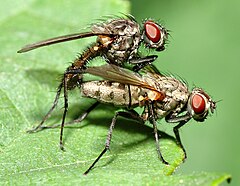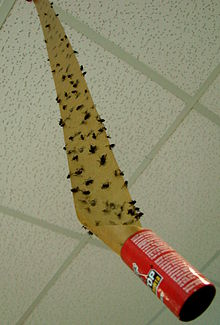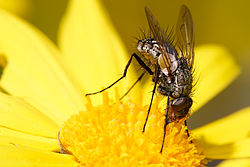Fly
| Flies | |
|---|---|

| |
| Scientific classification | |
| Kingdom: | |
| Phylum: | |
| Class: | |
| Subclass: | |
| Infraclass: | |
| Superorder: | |
| Order: | Diptera |
| Suborders | |
|
Nematocera (includes Eudiptera) | |
True flies are insects of the Order Diptera (Greek: di = two, and pteron = wing), possessing a single pair of wings on the mesothorax and a pair of halteres, derived from the hind wings, on the metathorax. The common housefly is a true fly and is one of the most widely distributed animals.
The presence of a single pair of wings distinguishes true flies from other insects with "fly" in their name, such as mayflies, dragonflies, damselflies, stoneflies, whitefly, fireflies, alderflies, dobsonflies, snakeflies, sawflies, caddisflies, butterflies or scorpionflies. Some true flies have become secondarily wingless, especially in the superfamily Hippoboscoidea, or among those that are inquilines in social insect colonies.
It is a large order, containing an estimated 240,000 species of mosquitos, gnats, midges and others, although under half of these (about 120,000 species) have been described [1]. It is one of the major insect orders both in terms of ecological and human (medical and economic) importance. The Diptera, in particular the mosquitoes (Culicidae), are of great importance as disease transmitters, acting as vectors for malaria, dengue, West Nile virus, yellow fever and other infectious diseases.
Ecology


Diptera are a diverse order with an enormous range of ecological roles. Every type of trophic level pattern can be seen in the Diptera. Dipteran predators include the robber flies (Asilidae).[2] A variety of herbivores can be found in the Diptera, such as the economically important fruit flies (Tephritidae). Flies are often parasites, including internal parasites such as the bot fly and external parasites such as the mosquito, black fly, sand fly or louse fly. Myiasis is the special term for flies infecting living tissue (such as the screw worm fly). Many flies eat dead organic matter detritovores, plant or animal remains. This is especially common in the larval stage, seen in the filter-feeding mosquitos and black flies to the dung-feeding blow flies (Calliphoridae) or the organic deposit feeding rat-tailed maggot. A number of taxa feed on blood, including horse flies and mosquitos. Flies are also important pollinators for many species of plant, and many species feed on pollen and nectar.
The basic fly life cycle is egg, larvae (maggots — see below), pupa and adult (winged stage), called holometabolism. There is often a difference in food sources for larvae versus adult dipterans of the same species. For example, mosquito larvae live in standing water and feed on detritus while the adults feed on nectar as their energy source while females utilize blood as their energy source for egg production.
Flies rely heavily on sight for survival. The compound eyes of flies are composed of thousands of individual lenses and are very sensitive to movement. Some flies have very accurate 3D vision. A few, like Ormia ochracea, have very advanced hearing organs.
Maggots

Some types of maggots found on corpses can be of great use to forensic scientists. By their stage of development, these maggots can be used to give an indication of the time elapsed since death, as well as the place the organism died. The size of the house fly maggot is 10–20 mm (⅜–¾ in). At the height of the summer season, a generation of flies (egg to adult) may be produced in 12–14 days.
Maggots are bred commercially, as a popular bait in angling, and a food for carnivorous pets such as reptiles or birds.
Various maggots cause damage in agricultural crop production, including root maggots in rapeseed and midge maggots in wheat. Some maggots are leaf miners.
Maggots have been used in medicine to clean out necrotic wounds [3], and in food production, particularly of cheeses (casu marzu).
Classification


There are two generally accepted suborders of Diptera. The Nematocera are usually recognized by their elongated bodies and feathery antennae as represented by mosquitoes and crane flies. The Brachycera tend to have a more roundly proportioned body and very short antennae. A more recent classification has been proposed in which the Nematocera is split into two suborders, the Archidiptera and the Eudiptera, but this has not yet gained widespread acceptance among dipterists.
- Suborder Nematocera (77 families, 35 of them extinct) – long antennae, pronotum distinct from mesonotum. In Nematocera, larvae are either eucephalic or hemicephalic and often aquatic.
- Suborder Brachycera (141 families, 8 of them extinct) – short antennae, the pupa is inside a puparium formed from the last larval skin. Brachycera are generally robust flies with larvae having reduced mouthparts.
- Infraorders Tabanomorpha and Asilomorpha – these comprise the majority of what was the Orthorrhapha under older classification schemes. The antennae are short, but differ in structure from those of the Muscomorpha.
- Infraorder Muscomorpha – (largely the Cyclorrhapha of older schemes). Muscomorpha have 3-segmented, aristate (with a bristle) antennae and larvae with three instars that are acephalic (maggots).
Most of the Muscomorpha are further subdivided into the Acalyptratae and Calyptratae based on whether or not they have a calypter (a wing flap that extends over the halteres).
Beyond that, considerable revision in the taxonomy of the flies has taken place since the introduction of modern cladistic techniques, and much remains uncertain. The secondary ranks between the suborders and the families are more out of practical or historical considerations than out of any strict respect for phylogenetic classifications. (Modern cladists tend to spurn the use of Linnaean rank names.) Nearly all classifications in use now, including this article, contain some paraphyletic groupings; this is emphasized where the numerous alternative systems are most greatly at odds. See list of families of Diptera.
Dipterans belong to the group Mecopterida, that also contains Mecoptera, Siphonaptera, Lepidoptera and Trichoptera. Inside it, they are sometimes classified closely together with Mecoptera and Siphonaptera in the superorder Antliophora [4].
Evolution
Diptera are among the most evolved insects, and are usually thought to derive from Mecoptera or a strictly related group. First true dipterans are known from the Middle Triassic, becoming widespread during the Middle and Late Triassic [5].
Cultural references

- The name Beelzebub is commonly translated as Lord of the Flies, although the meaning may originally have been quite different.
- In the Bible, one of the plagues of Egypt may have been a plague of flies.
- In traditional Navajo religion, Big Fly is an important spirit being.
- In Greek mythology, Myiagros was a god who chased away flies during the sacrifices to Zeus and Athena. Also, Zeus sent a fly to sting the horse Pegasus causing Bellerophon to fall back to Earth when he attempted to ride to Mount Olympus
- Extremely life-like flies were sometimes depicted in the trompe l'oeil paintings of the 15th century. An example is the painting Portrait of a Carthusian by Petrus Christus, showing a fly sitting on a fake frame [6].
- "Fly on the wall" is a phrase used to refer to an unnoticed observer.
- "No flies on you" is a phrase, common in the United Kingdom, to indicate that a person is not slow. Often used sarcastically.
- The 1958 science fiction film The Fly, remade in 1986, revolves around the accidental merger of a human and a fly.
- In 2001, Garnet Hertz produced an art project in which a complete web server was implanted into a dead fly. [1]
- Several recording artists have made reference to flies in their work, such as Yoko Ono's album Fly, and U2's single "The Fly".
- Emily Dickinson's poem "I Heard a Fly Buzz When I Died" also makes a reference to flies.
References
- ^ B. M. Wiegmann & D. K. Yeates (1996). "Tree of Life: Diptera".
- ^ F. Geller-Grimm. "Information on robber flies".
- ^ Ronald A. Sherman, MD, MSC, University of California (1998)©. "Maggot use of necrotic wounds".
{{cite web}}: CS1 maint: multiple names: authors list (link) CS1 maint: numeric names: authors list (link) - ^ "Taxon: Superorder Antliophora". The Taxonomicon. Retrieved 2007-08-21.
- ^ V. A. Blagoderov, E. D. Lukashevich & M. B. Mostovski (2002). "Order Diptera Linné, 1758. The true flies". In A. P. Rasnitsyn & D. L. J. Quicke (ed.). History of Insects. Kluwer Academic Publishers. ISBN 1-4020-0026-X.
- ^ "Portrait of a Carthusian, 1446". Timeline of Art History. The Metropolitan Museum of Art. October 2006.
Biology
- Harold Oldroyd The Natural History of Flies. New York: W. W. Norton.1965.
- Eugène Séguy Diptera: recueil d'etudes biologiques et systematiques sur les Dipteres du Globe (Collection of biological and systematic studies on Diptera of the World). 11 vols. Text figs. Part of Encyclopedie Entomologique, Serie B II: Diptera. 1924-1953.
- Eugène Seguy. La Biologie des Dipteres 1950. pp. 609. 7 col + 3 b/w plates, 225 text figs.
Classification
- Colless, D.H. & McAlpine, D.K.1991 Diptera (flies) , pp. 717-786. In: The Division of Entomology. Commonwealth Scientific and Industrial Research Organisation, Canberra (spons.), The insects of Australia.Melbourne Univ. Press, Melbourne.
- Griffiths, G.C.D. The phylogenetic classification of Diptera Cyclorrhapha, withspecial reference to the structure of the male postabdomen. Ser. Ent. 8, 340 pp. [Dr. W. Junk, N. V., The Hague] (1972).
- Willi Hennig Die Larvenformen der Dipteren. 3. Teil. Akad.-Verlag, Berlin. 185 pp., 3 pls. 1948
- Willi Hennig (1954) Flugelgeader und System der Dipteren unter Berucksichtigung der aus dem Mesozoikum beschriebenen Fossilien. Beitr. Ent. 4: 245-388 (1954).
- F. Christian Thompson. "Sources for the Biosystematic Database of World Diptera (Flies)" (PDF). United States Department of Agriculture, Systematic Entomology Laboratory.
- Willi Hennig: Diptera (Zweifluger). Handb. Zool. Berl. 4 (2 ) (31):1-337. General introduction with key to World Families. In German.
Evolution
- Blagoderov, V.A., Lukashevich, E.D. & Mostovski, M.B. 2002. Order Diptera. In: Rasnitsyn, A.P. and Quicke, D.L.J. The History of Insects, Kluwer Publ., Dordrecht, Boston, London, pp. 227-240.
